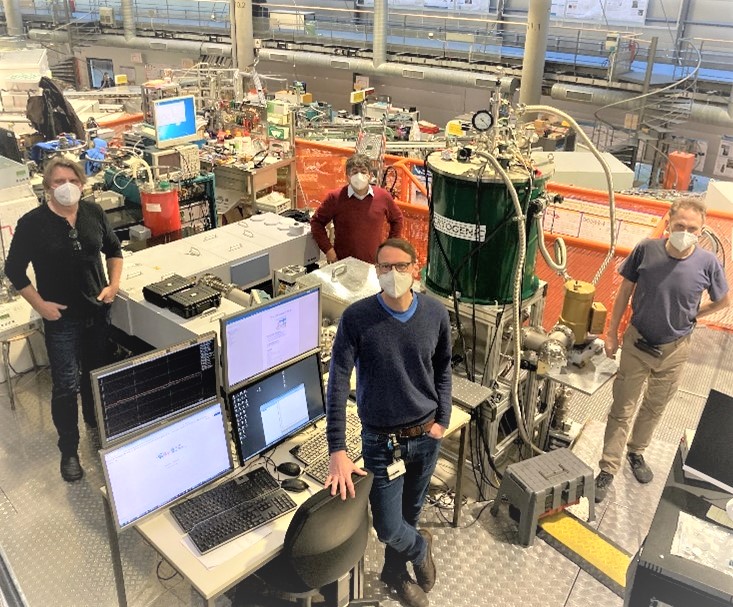New 12 T magnet on BESSY II’s experimental floor strengthens energy and magnetism research

Exhausted but happy: f.l.t.r. - K. Holldack (HZB), A. Schnegg (MPI CEC Mülheim, HZB), T. Lohmiller (HZB, HUB), D. Ponwitz (HZB) after the successful commissioning of the new 12T magnet (green).
Electron paramagnetic resonance (THz-EPR) at BESSY II provides important information on the electronic structure of novel magnetic materials and catalysts. In mid-January 2022, the researchers brought a new, superconducting 12-T magnet into operation at this end station, which promises new scientific insights.
At the THz-EPR end station, unique experimental conditions are provided through a combination of coherent THz-light from BESSY II and high magnetic fields. These capabilities have now been extended by a new superconducting 12 T magnet, acquired through funding from the BMBF network project “ERP-on-a-Chip” and HZB.
“The extended capabilities of the new setup will allow exciting new science with user groups and within our joint lab EPR4Energy operated together with Max Planck Institute for Chemical Energy Conversion, Mühlheim. We are very pleased about the successful commissioning of the superconducting magnet, which currently delivers the highest magnetic field at BESSY II”, says Karsten Holldack, the responsible beamline scientist.
(red)
https://www.helmholtz-berlin.de/pubbin/news_seite?nid=23346;sprache=en
- Copy link
-
The twisted nanotubes that tell a story
In collaboration with scientists in Germany, EPFL researchers have demonstrated that the spiral geometry of tiny, twisted magnetic tubes can be leveraged to transmit data based on quasiparticles called magnons, rather than electrons.
-
Ernst Eckhard Koch Prize and Innovation Award on Synchrotron Radiation 2025
At the 27th BESSY@HZB User Meeting, the Friends of HZB honoured the dissertation of Dr Enggar Pramanto Wibowo (Friedrich-Alexander University Erlangen-Nuremberg). The Innovation Award on Synchrotron Radiation 2025 went to Prof. Tim Salditt (Georg-August-University Göttingen) and Professors Danny D. Jonigk and Maximilian Ackermann (both, University Hospital of RWTH Aachen University).
-
Bright prospects for tin perovskite solar cells
Perovskite solar cells are widely regarded as the next generation photovoltaic technology. However, they are not yet stable enough in the long term for widespread commercial use. One reason for this is migrating ions, which cause degradation of the semiconducting material over time. A team from HZB and the University of Potsdam has now investigated the ion density in four different, widely used perovskite compounds and discovered significant differences. Tin perovskite semiconductors produced with an alternative solvent had a particular low ion density — only one tenth that of lead perovskite semiconductors. This suggests that tin-based perovskites could be used to make solar cells that are not only really environmentally friendly but also very stable.
